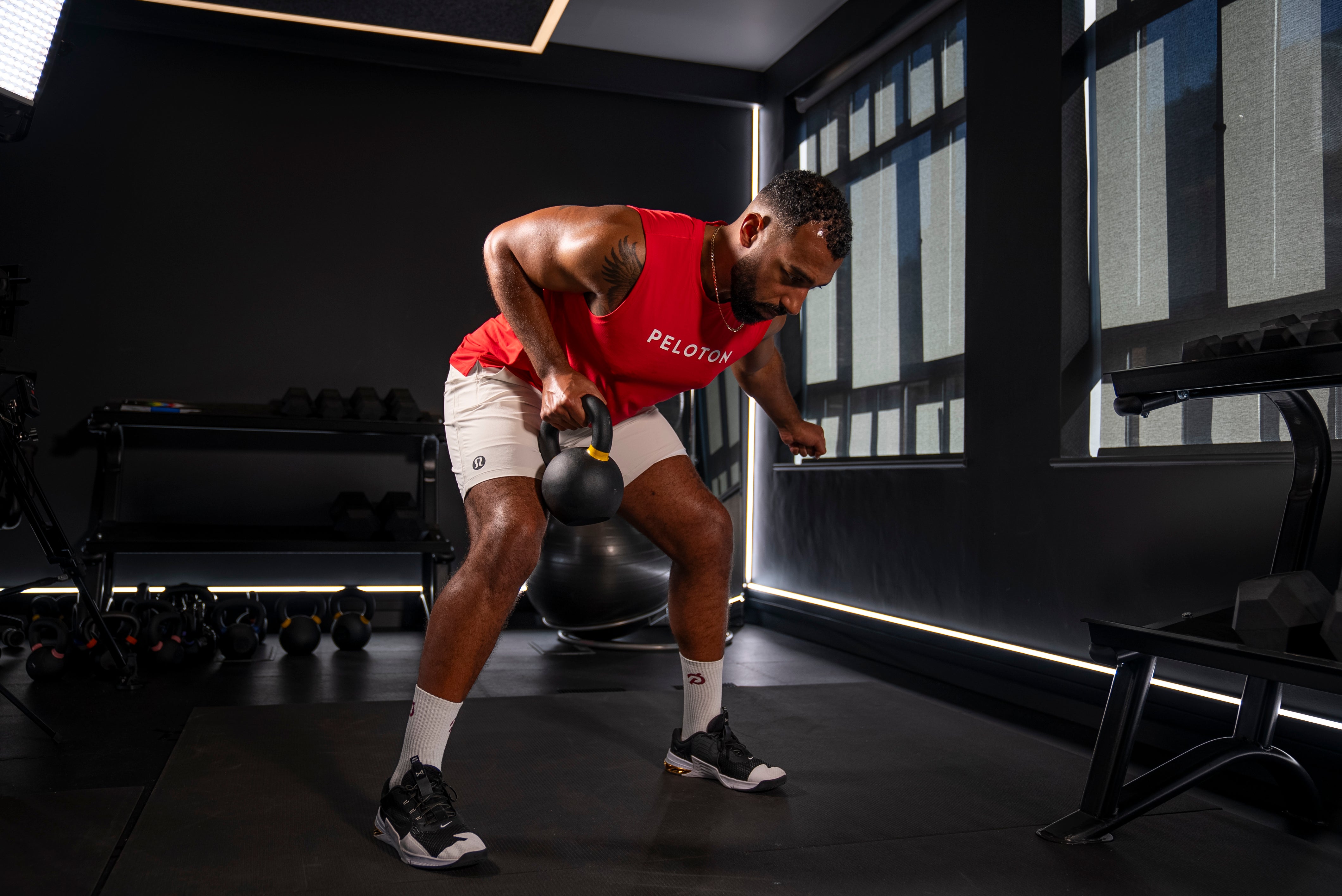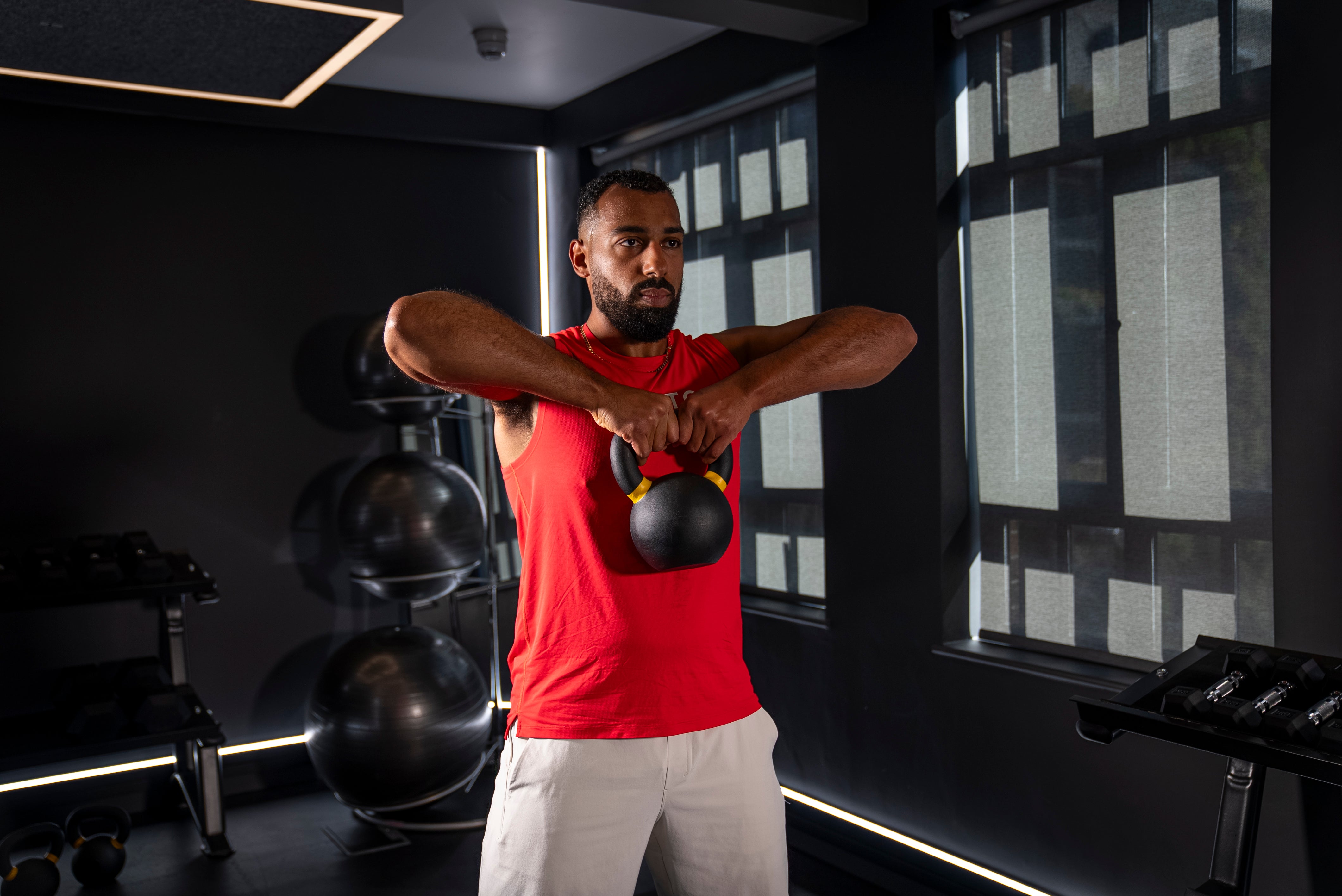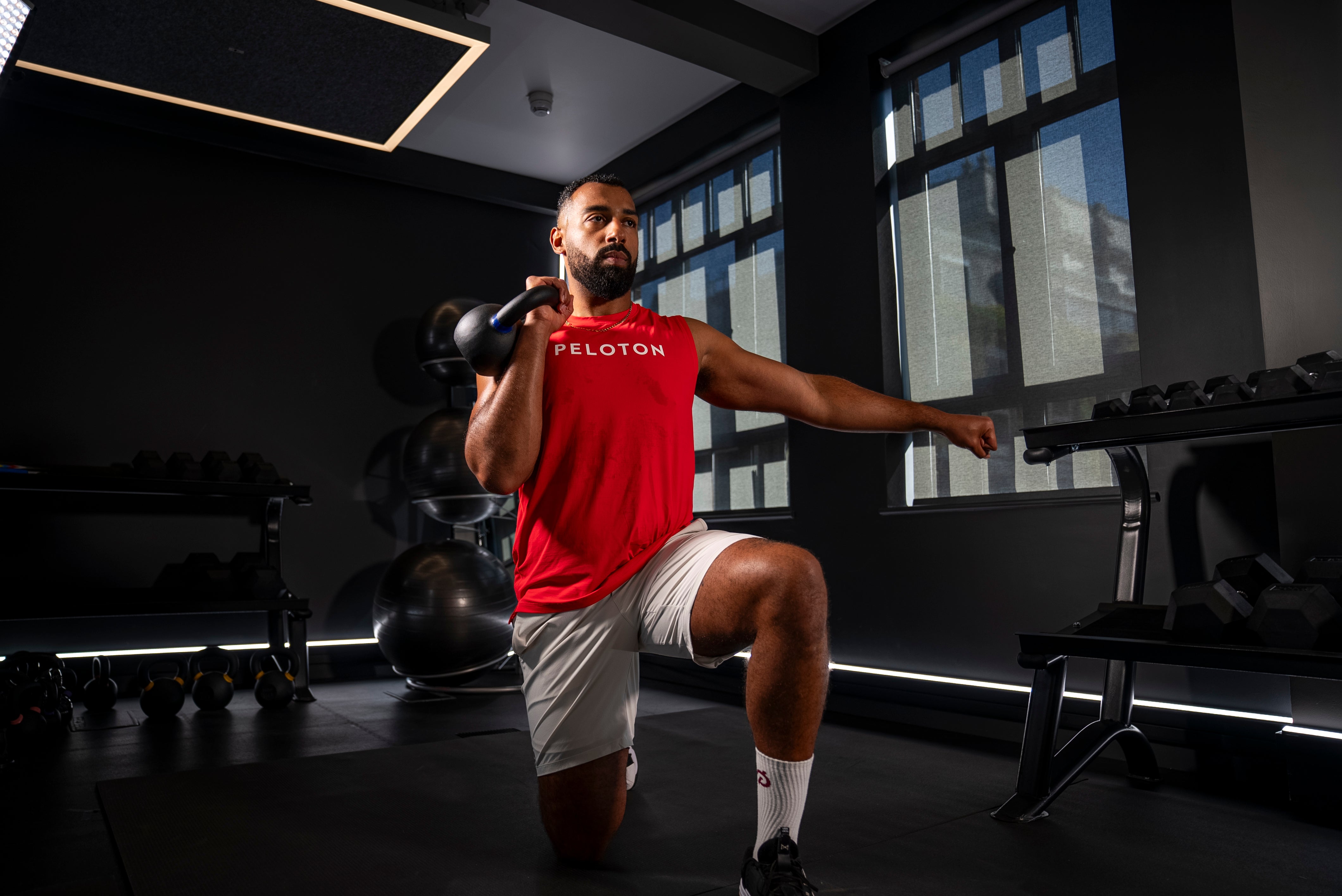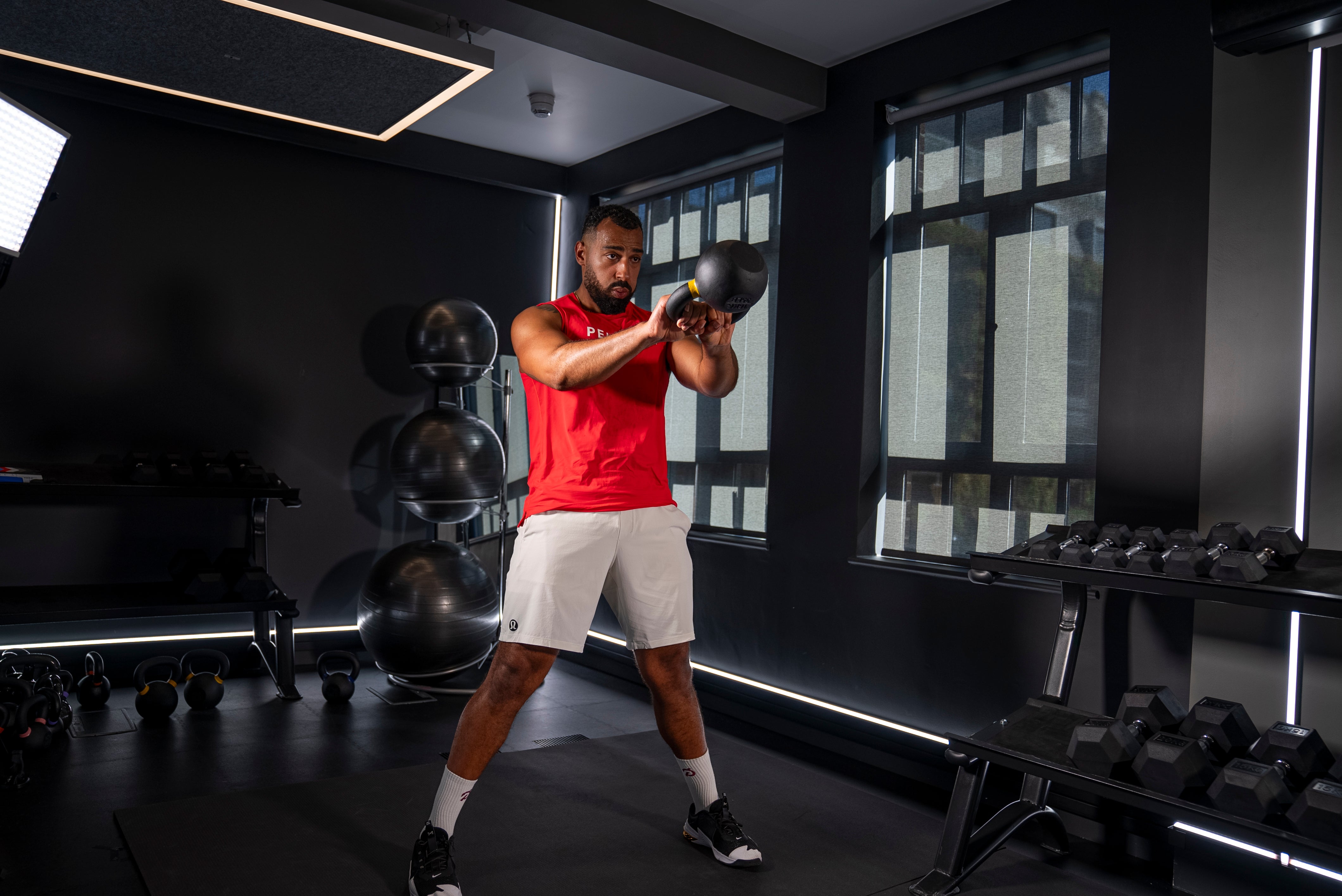
The kettlebell is the most underappreciated fitness tool there is. With just one weight, you can challenge your entire body and develop every element of fitness imaginable; strength, endurance, cardio, mobility and more. Yet dumbbells, barbells and machines tend to be more highly favoured.
If you’re reading this, it’s your sign to give kettlebells the credit they deserve – something fitness behemoth Peloton plans to do with its new kettlebell classes.
So, if you’re new to kettlebells where should you start? Instructor Jermaine Johnson prescribes the five-move workout below, comprising a circuit of his favourite exercises.
“Kettlebell training is one of the best ways to build functional strength, power and mobility,” he tells The Independent.
“Unlike traditional strength training, kettlebells move with you, forcing your core and stabilisers to engage as you would carrying shopping, playing with your kids or running outdoors on uneven terrain. The offset weight improves balance and coordination, while explosive moves like swings and snatches build power and endurance.”
How to do Peloton instructor Jermaine Johnson’s five-move kettlebell workout
Complete four rounds of the circuit below:
- Kettlebell front squat x10
- Kettlebell single-arm row x10 (each side)
- Kettlebell deadlift to high pull x10
- Kettlebell half-kneeling press x10 (each side)
- Kettlebell swing x45 seconds
These exercises can help you build full-body strength, Johnson says. The row and press have bonus benefits because they’re unilateral (or one-sided) exercises. “These can help correct imbalances in the body as well as strengthen the core,” he explains.
He also suggests starting with a light kettlebell if you’re a beginner, and having a range of different weight options available if possible. This is because the main working muscles vary per exercise, so it’s likely your large leg muscles will be able to move more weight during the front squat than your smaller shoulders can shift during the half-kneeling presses.
How to master the kettlebell front squat

- Hold the kettlebell tight to your chest with both hands.
- To initiate the movement, push your hips back as if you were sitting into a chair behind you, then bend your knees to lower your hips towards the floor.
- Descend to the lowest point where you can maintain a long spine and keep your chest up, then drive through your feet to return to standing.
- “Inhale on the way down and exhale on the way up, breathing into your core,” Johnson advises.
Common mistakes and how to fix them
“A common mistake with this exercise is letting the knees cave in. To fix this, keep your toes angled [outwards slightly], thinking of an 11 o’clock and 1 o’clock on a clock. Your knees will then track where they need to.”
Benefits
Most kettlebell movements are compound exercises, meaning they recruit multiple joints and muscles at once. This one sees your hips, knees and ankles under the spotlight, meaning it’s recruiting (and building strength in) all the major muscles across your lower body like the quads, hamstrings and glutes, as well as your core.
How to master the kettlebell single-arm row

- Stand with your feet roughly shoulder-width apart then hinge at the hips until your torso is parallel to the floor, spine long.
- Grasp the kettlebell with your right hand so your knuckles are facing to the right, then row it up to your rib cage. Think about driving your elbow back and up to do this.
- “Squeeze your shoulder blades together at the top of the row for better activation and engage your core throughout,” Johnson advises.
- Control the kettlebell back to the floor, repeat for 10 total repetitions, then switch arms.
Common mistakes and how to fix them
“I often see rounding or over-arching of the back, and jerking the weight up with unnecessary force, during this exercise. To prevent over-arching of the back, brace your core and maintain a neutral spine. Keep your ribcage down and engage your lats. To prevent jerking, keep the movement slow and controlled.”
Benefits
Another compound exercise, the single-arm row primarily works the lats (the broad muscles across your back) and the biceps. It will also engage many muscles across your core as well to keep your stable.
How to master the kettlebell deadlift to high pull

- Start in a deadlift position with a stance slightly wider than shoulder-width and the kettlebell between your feet.
- Grab the kettlebell in both hands with an overhand grip.
- Keeping your spine long, and your chest and eyes up, drive your hips forward to stand up straight. Use this momentum to bring the kettlebell up to chest height, pushing your elbows out to the side, then control it back to the starting position.
- “Keep the Kettlebell close to your body throughout,” says Johnson.
Common mistakes and how to fix them
“Overuse of the lower back, instead of the glutes and hamstrings, is one of the most frequent mistakes with this move. To fix this, sit deep in the hinge [pushing the hips back], which is more efficient in maintaining a neutral spine.”
Benefits
“The high pull is an explosive movement pattern that works the posterior chain [muscles on the back side of your body]; the glutes and hamstrings, as well as the upper and mid-back,” Johnson explains.
How to master the kettlebell half-kneeling press

- Start in a half-kneeling position (or lunge, with one knee on the ground, and the other foot planted under a vertical shin so your knees both form right angles).
- Hold the kettlebell in a front rack position, nestled between your shoulder and forearm, on the same side as the front knee.
- “Press the kettlebell overhead while engaging your core for stability,” Johnson says. “Keep your front knee in line with your toes, and focus on having a straight up and down movement while maintaining a stable torso.”
- Control the kettlebell back down to the front rack position.
- Repeat for 10 total repetitions, then switch to the other side.
Common mistakes and how to fix them
“A common fault here is arching your back and letting the wrist collapse. To fix, squeeze your glutes and engage your core to keep your ribs stacked over your hips – avoid leaning back and press straight up. Keep your wrist stacked and don’t let it bend backwards.”
Benefits
The half-kneeling press is an excellent way to strengthen your shoulders and triceps – the muscles running down the back of your upper arm. As with the majority of kettlebell exercises, your core musculature is also called into action to play a stabilising role.
How to master the kettlebell swing

- “This is a ballistic movement, meaning it requires explosive power,” says Johnson.
- Start with your feet outside shoulder-width and the kettlebell on the ground in front of you.
- Push your bum back to hinge at the hips and keep your spine long as you hinge down to grab the kettlebell with a double overhand grip.
- Brace your core, then pull it back and up between your thighs while keeping your arms straight. At this point, your chest should be facing the floor
- From here, explosively drive your hips forward to propel the kettlebell forward and up so it arcs in front of your body. Again, your arms should be straight throughout.
- Allow it to fall back down between your thighs and repeat.
- “Use a powerful hip snap to generate momentum,” says Johnson. “Keep your arms relaxed and remember that the power comes from your lower body.”
Common mistakes and how to fix them
“People sometimes use the upper body [rather than the hips] to generate momentum as they swing, and they swing the kettlebell higher than chest level. To fix this, think about driving the movement with your hips, not your arms – think of the kettlebell as an extension of your hips. Maintain a smooth, controlled swing rather than muscling it up by shrugging or pulling with your arms.”
Benefits
“This is a conditioning movement which adds a cardio element to your workout,” says Johnson. “The move works your glutes, hamstrings and core.”
So there you have it. If you’ve never tried using a kettlebell before, this is the perfect route in. An ideal workout from a master coach, a kettlebell routine is great for those who are time poor and looking for an effective workout at home.







